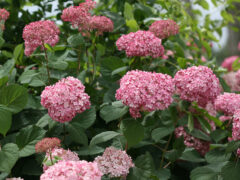
Hosta ‘Minute Man’
Hosta 'Minute Man'
A sport of ‘Francee’, this little hostas has stunning, very dark green leaves are surrounded … Continued
Drought-tolerant and drought-resistant plants may still need supplemental water from time to time, but they can survive periods of dryness without dying.
Drought-resistant plants like cactus, hens and chicks, and sedums can go for very long periods without water and do not tolerate poorly drained locations. Drought-resistant tropical plants grown indoors in winter like cactus, Sansevieria, Echeveria, and other succulents sometimes fail due to overwatering.
Drought-tolerant plants grow in many textures and sizes and have different adaptations that help them get through periods of drought:
The latter two types of plants are drought tolerant once established because any new planting, regardless of drought tolerance, needs to be watered during the first growing season to allow roots to reach the depths needed to access moisture during dry periods.
It’s also important to note that survival may not mean that the plant will look its best during this time. Watering weekly for a longer period of time will result in the best-looking gardens with the highest tolerance for drought. During the hottest, dryest times in summer, watering deeply twice a week is recommended. These less frequent waterings will encourage root systems to expand, making it easier for plants to access moisture when their environment is dry.
Winter drought has become a bigger problem in recent years as snowfall declines. Evergreen plants are especially vulnerable during winter drought because their foliage continues to shed moisture while dormant deciduous plants have shed their leaves and can conserve moisture in woody stems and underground. Watering shrubs and trees in winter on days when the temperature allows (above freezing) will help ensure their healthy return in spring.
Here are some drought-tolerant and drought-resistant plants to grow—

Hosta 'Minute Man'
A sport of ‘Francee’, this little hostas has stunning, very dark green leaves are surrounded … Continued

Hosta 'Patriot'
Leaves have dark green centers and crisp white, streaked margins. Leaves are slightly wavy and … Continued

Hosta plantaginea × H. sieboldiana (Grulleman/Wayside/AHS 1986)
‘Royal Standard’ was the first hosta to receive a plant patent in 1965. Plants form … Continued

Hosta (R & D Benedict 1990)
Vigorous grower that forms a dense mound, 16″ h x 40″ w of green leaves … Continued

Hosta 'Silk Road'
Deep green centers and wide creamy yellow to creamy white margins cover about half of … Continued
Hosta 'Stiletto'
This fast grower makes a great groundcover with long narrow green leaves with a rippled … Continued

Hosta (Banyai/Solberg 1991)
Yellow leaves are edged in dark green. Vigorous growth and purple flowers in mid-summer. Plants grow … Continued

Huernia zebrina
The five-pointed, yellow-red, star-shaped flowers are bonded with a red lifesaver. Easy to grow in … Continued

Hydrangea arborescens nvincibelle® Spirit II
An improved version of the original pink ‘Annabelle’ hydrangea, Invincibelle Spirit II has dark green … Continued

Hydrangea paniculata
The most compact panicle hydrangea, this shrub tops out at just 2 to 3′ tall … Continued

Hydrangea quercifolia
An upright, multi-stemmed, deciduous shrub that typically grows 4-6′ and produces showy panicles of white … Continued

Hydrangea paniculata 'Little Lime'
This petite panicle hydrangea tops out at 3-5’ tall and wide with lime green summer … Continued